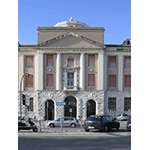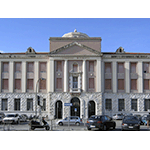Ospedale di Livorno [Livorno Hospital]
Among the Livorno initiatives, in the field of preventive medicine, "lazzaretti" had already been built at the time of Grand Duke Francesco I de' Medici. These were places specifically designed for the quarantine of suspected travellers and merchandise, to prevent the spread of dangerous epidemics. The first to be built was San Rocco (late 16th century), situated on the rocks where the Lighthouse tower (Fanale dei Pisani) stood. The project for building the new pest-house was accompanied by a revision of the regulations on health and by the institution, in 1606, of a Magistrate of Health residing in Livorno. Another place of quarantine was San Jacopo, to which was added, in 1769, San Leopoldo.
The Livorno medical situation was reorganised by Peter Leopold of Lorraine. In 1777 the Grand Duke ordered a thorough inspection of the city’s hospitals, having decided to improve the existing facilities, which had been remodelled and enlarged to some extent already in the previous century. In the 18th century the Livorno medical system still consisted, as in the 17th, of two main structures: the Hospital of San Antonio for men and that of Santa Barbara for women. There was also a third hospital run by the nuns of SS. Annunziata and of San Ranieri, situated in the former Jesuit monastery. Among the innovations was a project for unifying the entire healthcare system in a single general hospital to be set up on the premises of the San Rocco lazzaretto, but in reality only the three hospital administrations were unified, in 1787, under the direction of a governmental commissary.
In his Guida di Livorno, Piombanti refers to the establishing in Livorno of a Medical Academy or Society. Founded in 1825, the society had as its scope "the increment of the medical-surgical science and public utility. Its members included physicians, surgeons and pharmacists. Approved by the governmental authorities, it awarded diplomas to its members, and held meetings above the beautiful and rich Villoresi Pharmacy next to the Prefecture. The members read scientific papers, assisted the Confraternita della Misericordia, provided free examinations and operations for the poor, and also administered medications to them." Its statutes were reformed twice, and the society was dissolved 40 years later, in 1865.
Today, Livorno Local Health Department 6 presides over the Costanzo Ciano Hospital, inaugurated in 1932 in the building in Viale Alfieri which it still occupies today. Its collection of medical-scientific instrumentation consists of objects utilised by the hospital over the course of the 20th century or coming from other medical institutions in the city. These include a radiology machine made in the United States dating from the time of World War II as well as pestles and pharmaceutical equipment. These objects are displayed as decoration in nine of the Hospital’s clinics.
****************************
Texts by Antonella Gozzoli
English translation by Catherine Frost
Last update 28/feb/2008





